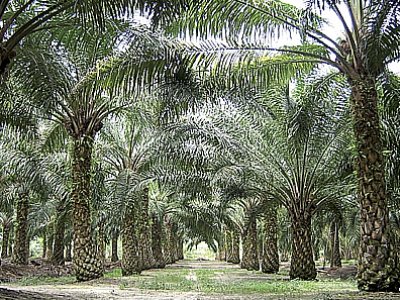Phuket Gardening: What’s in a potted palm?

PHUKET: A few weeks ago I had occasion to visit a friend staying at the Evason Resort in Rawai.
There is an impressive drive to be negotiated before you reach your destination, a route dominated by over-arching palms that have obviously been there for some time probably installed at the same time as the hotel itself.
What made this roadside palm arbor all the more memorable was the fact that each individual tree had ferns of various kinds sprouting from its trunk, growing from the pockets of leaf bases left after dead fronds had been removed from the stem. Clearly these ferns did not lack for shade or water, since nutrient-enhanced rain, trapped by the crown of fronds, filtered down and into these moistened pockets.
There were ferns of many kinds: maidenhair, Boston ferns (neprolepsis), even stag’s horn ferns (platycerium), elkhorn ferns and bird’s nest ferns (asplenium). And all these epiphytes owed their continuing existence to one of the most vilified of trees – the oil palm.
Oil palms have an unenviable reputation. True, they are an important cash crop in southern Thailand and Malaysia, the source not only of Thailand’s most used cooking oil, but also of bio-fuel. However, and so conservationists maintain, these plantations exist at the expense of bio-diverse rainforest, of vanishing peat swamps and much else besides. Hardly surprising that elaeis oleifera should be both environmentally vilified and commercially valued.
But here, in Rawai at least, they were contributing to the environment in a very positive way. Planted in serried ranks, with dense clusters of feathery, dark green fronds atop each tree, these avenues of palms gave the approach road a distinctive appearance. And if you want to grow ferns in your garden, maybe you should look no further than starting with a mature oil palm or two of your own. They are sizable trees, up to fifteen meters tall, but they are easily grown from seed. Moreover, they like sun and high humidity both available in spades in Phuket.
Another palm associated more with commercial activity than aesthetic value is the sugar palm (borrasus flabillifer), which is grown in huge plantations for a sweet sap called ‘toddy’, which can be converted into sugar or, more bizarrely, into an alcoholic drink called ‘arrack‘. With the escalating prices of alcohol in Phuket’s bars, maybe it’s worth producing your own.
But seriously, every part of this palm is variously used in South East Asia for timber, thatching and food. However, you will need a large garden to accommodate it. The immature trees look odd, with a thick, knobbly trunk covered with leaf bases, and huge fan-shaped leaves, but it can look effective when planted in rows as was done on the central reservation of the airport road.
But for value as garden palms, neither of these would be in my top half-dozen. I would still go with the Bismarck palm, the traveler’s palm, the yellow cane palm, the sealing-wax palm and the foxtail palm as the best choices for your garden. And for sheer durability, the fish-tail, or its larger cousin the wine palm, is difficult to beat. As for dense ground cover, you would be hard-pushed to find a better choice than the rhapsis or lady palm, which, like the wine palm, will tolerate deep shade. It grows in graceful clumps with slender and fan-shaped leaves and rarely exceeds two meters. And along with the fish-tail, it remains the best of all palms to grace your living room as a potted specimen.
Tip of the week – Planting out container plants
Nowadays garden center plants usually come in containers small ones in black sheet plastic or larger ones in rigid plastic pots.
Always plant your new acquisition in a hole larger than the root ball, and, holding the plant in position, backfill the space around it with the unamended soil you dug from the hole.
If the existing soil is poor, use a potting mixture or good top-soil that will encourage root growth outwards and downwards. Add the soil in stages, firming it around the roots with your hands as you work. The top of the root ball should be about an inch above the surrounding soil.
Finally, make a ridge (berm) of soil around the plant to form a watering basin. Irrigate gently but thoroughly, add a little fertilize and finally a layer of mulch.
Phuket Gardening is Phuket Gazette columnist Patrick Campbell’s feature of all things flora.
If you have a question or a garden that you would like featured, you can email Patrick Campbell here.
Keep checking our online Phuket Lifestyle pages for regular gardening features and tips.
— Patrick Campbell
Latest Thailand News
Follow The Thaiger on Google News:


























